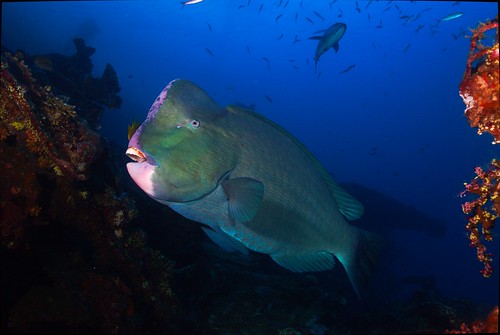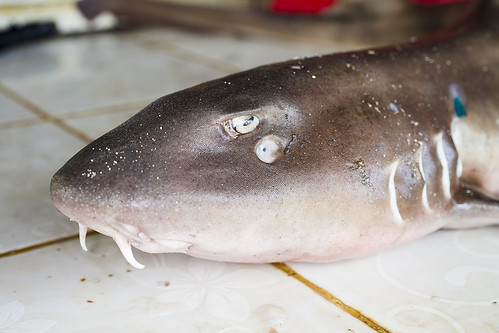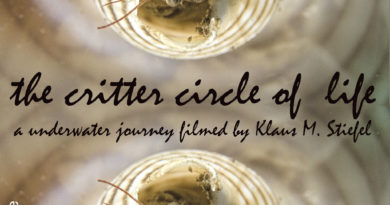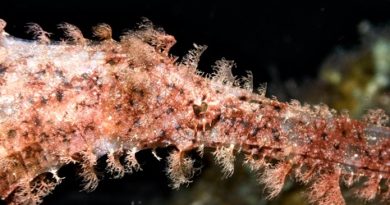Why Spearfishing on Scuba is a Bad Idea in Any Case
Some people like to spearfish. When doing that on breath-hold, as apnea divers, that’s a significant challenge, and while I don’t partake, I respect the effort it takes to dive on a single breath and stalk a fish which is in its element. Spearfishing on apnea can still cause ecological problems, but they are likely not as aggravated as when spearing fish on scuba, simply because it’s harder and you’ll get fewer fish out of the ocean.
Spearfishing on scuba, with a tank, and wile being able to stay underwater for close to an hour per dive, is much less challenging, and getting close to many non-roving fishes, like moray eels, on scuba, is no achievement at all; spearing them is akin to picking apples in terms of challenge. Being able to get more fish with less effort is part of the problem.
There are three main problems with spearfishing on scuba, though, and in logical order these are: it might be illegal where you are, it might be unsafe if you have to do it to eat, and it is likely ecologically harmful. Let’s look at these problems in this order:
It’s Illegal in Some Countries
In some parts of the world, spearfishing on scuba is illegal.
In the US, it’s typically legal if not prohibited by local laws.
Same in the Philippines, there is no federal law prohibiting spearfishing on scuba. Republic act 8550 prohibits “active fishing gear” use in municipal water, and spearfishing can be interpreted as “active gear”, but the authorities don’t see it as such. And there is, to my knowledge, no explicit mention of scuba gear in any Philippine national fisheries laws. There are two caveats here, though: Municipalities (cities and districts, the political level below the province; sometimes called local government units, LGUs) will often have their own fisheries codes, and in these codes spearfishing on scuba can be made illegal. Also, spearfishing in marine protected areas, and targeting protected species like marine turtles is of course illegal.
It’s illegal in most of Europe.
But what if it’s legal where you are, or if you don’t care that it’s illegal?
If You Need To Spearfish To Eat, It’s Probably Unsafe
A lot of people in my home-country of choice, the Philippines, need to catch fish to be able to have a decent source of protein. I have all the sympathy for them, and don’t want to keep them from fishing, but I wish they did it in a safe way.
When some of these guys (it’s almost always guys) go spearfishing on scuba, bad things happen. If you can’t afford to buy your protein in the market, you probably can’t afford well-serviced scuba gear and a dive computer (300+ Euro typically for entry-level models) which tells you when it’s time to go up to avoid decompression illness.
On top of the lack of safe equipment, a lack of training and a lack of restraint play a role. There are lots of dudes in the Philippines who use scuba gear without formal training, which can go well or not. Seeing a big fish just 10 meters deeper from where you are will make you go these 10 meters deeper if you are hungry and the wife will be upset at you if you come back fish-less. Add to that some nitrogen narcosis clouding your judgement…. These are unsafe dynamics which don’t exist in recreational scuba diving.
Task loading is an important concept in scuba training. A deep dive or a night dive will become more challenging when the diver has to divide his mental capacities over one more task (chasing a fish). This adds risk.
In my personal bubble in the Dumaguete/Philippines area alone, 2 serious accidents had happened in the last 2 years: A local divemaster died in 2020 after going on a spearo trip on scuba, and going way too deep, surfacing too fast and being unable to get to a decompression chamber (due to financial reasons). And, a friend of mine ended up in the hospital after a similar but less severe incident – he is fine now, but it certainly was a scare.
If your personal economic situation is so weak that you need to go on a dive to eat, it’s likely not safe to go on that dive. But what if you can afford safe scuba gear, and proceed carefully?
If You Don’t Need To Spearfish To Eat, You Are Causing Avoidable Ecological Trouble
If you are well off and don’t need to spearfish on scuba to eat, ask yourself, is it the environmentally sound thing to do?
Erst kommt das Fressen, dann kommt die Moral.
(First comes the feasting, then comes morality)
Bert Brecht
There are a number of studies which show that spearfishing can cause considerable harm to ecosystems, due to the tendency of spearfishermen to take the largest, most reproductively active fish. I strongly suspect that this is even more so the case for spearfishing on scuba, where one can kill fish without the time-limit imposed by a breath hold.
A study of a marine ecosystem in Chile titled “Spearfishing to depletion: evidence from temperate reef fishes in Chile” (Godoy et al., 2010) the authors looked at what fishes are targeted by spearfishers, and how their populations are doing. They state “Results show that the three largest and most emblematic reef fishes targeted mainly by spearfishers (>98% of landings) […] show signs of depletion in terms of abundance and size.”. They recommend “bans or strong restrictions on the use of SCUBA and hookah diving gear for spearfishing,”.
In the reproductive behavior of the California sheephead, an iconic fish in the kelp ecosystem, the fish turn from female to male above a certain size; spearfishing selectively removes the larger fish, which are all males, and hence the populations dwindled in some areas due to a lack of males.
Alonzo and colleagues (2004) write that “Large, old individuals are especially vulnerable to depletion by recreational spearfishing because of the ease at which they can be spotted and speared” and “However, male and total SPR (spawning potential ratio) appear to be reduced by a much greater amount”. Hence, specifically taking out big fish can cause particular damage to a fish population.

A study by John Turnbull and colleagues showed that in Australia, even partially protected “marine protected areas” (quotation marks used in purpose!) have almost no effect on the quality of the ecosystem, likely almost all due to recreational fishing. The authors state that “Partially protected areas had no more fish, invertebrates, or algae than open areas;”. Spearfishing is actually illegal in the partially protected areas investigated in this study, but it was one of the non-enforced infractions spotted. This study is not specifically about spearfishing, but I think it’s very insightful since it shows how much damage recreational fishing can do.
These are just a few examples from a sizeable literature on the ecological effects of spearfishing (or recreational fishing in general, in one case). Increase the bottom time per dive from 2 minutes (breath-hold) to 60 minutes (scuba), and it’s almost guaranteed that these problems will increase in severity.
A marine protected area where fish are allowed to thrive.
In Conclusion
It’s not just “a few fish, which I all eat”. It’s not just you, and it’s often the most important fish for the fish population which spearfishermen take. Spearfishing can harm ecosystems considerably. At least do it on breath hold, where there is more of a challenge to it and you generally end up taking fewer fish.
Some folks spearfish on scuba to be able to eat enough protein, but given their likely poor financial situation, their dive gear/training might not be up to the task to do it safely. If you are not one of these guys and have the choice, you should be under no illusion that your spearfishing is sustainable; Spearfishing on scuba (versus breath-hold) most likely aggravates its problems.
No Moralizing
I am not into moralizing. I am not here to tell you what to do, but to point out the consequences of your actions. You are the one to decide on your action, hopefully partially based on new (to you) information in this article.
References
Alonzo, S. H., Key, M., Ish, T., & MacCall, A. (2004). Status of the California sheephead (Semicossyphus pulcher) stock (2004). Center for Stock Assessment Research, California Department of Fish and Game, University of California Santa Cruz, and National Marine Fisheries Service, Santa Cruz, California, USA.
Godoy, N., Gelcich, S., Vásquez, J. A., & Castilla, J. C. (2010). Spearfishing to depletion: evidence from temperate reef fishes in Chile. Ecological Applications, 20(6), 1504-1511.
Turnbull, J. W., Johnston, E. L., & Clark, G. F. (2021). Evaluating the social and ecological effectiveness of partially protected marine areas. Conservation Biology, 35(3), 921-932.



